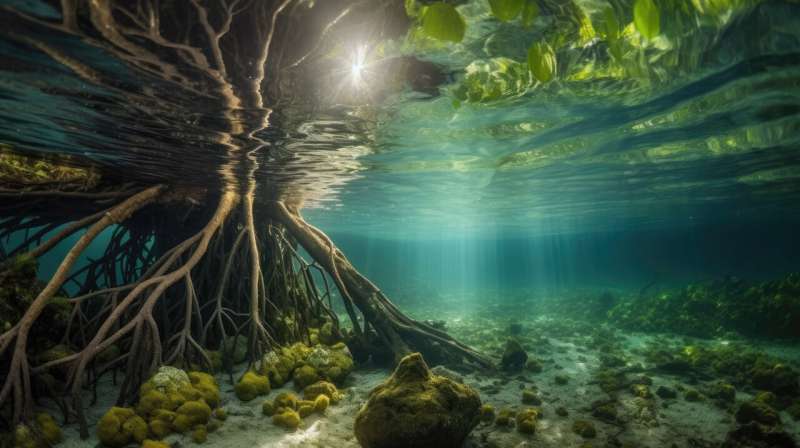This article has been reviewed according to Science X's editorial process and policies. Editors have highlighted the following attributes while ensuring the content's credibility:
fact-checked
peer-reviewed publication
trusted source
proofread
Improved mangrove conservation could yield cash, carbon, coastal benefits

A shift in the way we think about the benefits mangroves provide to coastal regions could yield significant economic and biodiversity gains and protect millions from flooding, research has revealed.
The University of Queensland-led study shows current conservation efforts typically target biodiversity protection while minimizing conflict with economic interests, failing to consider the huge benefits provided by ecosystems. The research is published in Nature Communications.
Alvise Dabalà, now at the University of the Azores and whose Masters project at UQ formed the basis of this study, said human activities, such as deforestation and coastal development have led to extensive mangrove loss across the globe.
"They protect infrastructure and communities from storms, sequester carbon, and provide fisheries with nursing grounds, so their rapid destruction is devastating to witness," Mr. Dabalà said.
"As it stands, current conservation efforts just aren't doing enough to take advantage of these services."
The team is using the United Nations' "Global Biodiversity Framework," which recommends an increase in protected areas to 30% of the world as the basis of their proposal.
Researchers are recommending an optimized conservation planning perspective that operates within this framework and puts more emphasis on these ecosystem services.
"It's somewhat of a juggling act, where we have to consider the trade-offs between biodiversity protection, economic conflicts, and ecosystem services," Mr. Dabalà said.
"But if done properly, this target has the potential to safeguard AU$25.6 billion of coastal property value, globally.
"It would also protect 6.1 million coastal-dwelling people against the impacts of flooding, and safeguard over one billion metric tons of sequestered carbon.
"In Australia alone, we've identified priority areas in Northern Queensland, Darwin and East Arnhem in the Northern Territory, and between Pilbara and Kimberley in Western Australia.
"Expanding Australian mangrove protection would be particularly beneficial for carbon sequestration and biodiversity conservation as they stand out as some of the most diverse, carbon-rich mangrove forests."
UQ's Professor Anthony Richardson said to achieve these outcomes boils down to a shift in perspective.
"In some areas of the world, we recognize that human pressure could be so high that the value of ecosystem services would not compensate for the loss and could result in complications in implementing protection," Professor Richardson said.
"However, for multiple ecosystems, including mangroves, we've quantified the benefits associated with considering the services these ecosystems provide—the figures are undeniable.
"We know that long-term gains from biodiversity protection are often greater than short-term gains from anthropogenic activities, so this shift in thinking must happen soon."
Professor Richardson said developing biodiversity and ecosystem services data should be a priority to incorporate into applied conservation plans.
"Implementation of these plans should then follow different conservation practices that target local communities' needs specifically," he said.
"Moving forward, decision-makers and other stakeholders need to focus on protected area implementation, management, and monitoring to provide solid conservation outcomes."
More information: Alvise Dabalà et al, Priority areas to protect mangroves and maximise ecosystem services, Nature Communications (2023). DOI: 10.1038/s41467-023-41333-3
Journal information: Nature Communications
Provided by University of Queensland


















